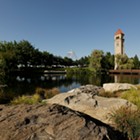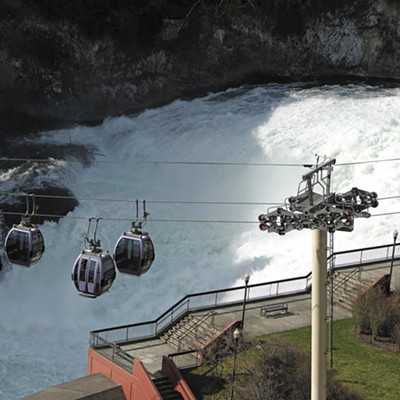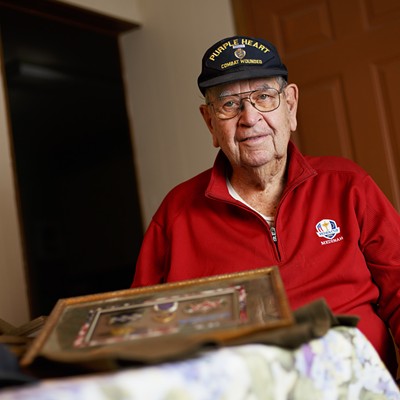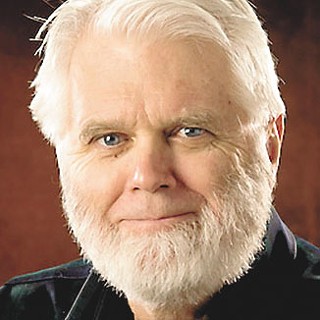The Case For Light Rail
[
{
"name": "Broadstreet - Instory",
"insertPoint": "5",
"component": "25846487",
"requiredCountToDisplay": "5"
},{
"name": "Broadstreet - Instory",
"insertPoint": "10",
"component": "25846487",
"requiredCountToDisplay": "10"
},{
"name": "Broadstreet - Instory",
"insertPoint": "15",
"component": "25846487",
"requiredCountToDisplay": "15"
},{
"name": "Broadstreet - Instory",
"insertPoint": "20",
"component": "25846487",
"requiredCountToDisplay": "20"
}
]
by Robert Herold
As we consider whether to give the Spokane Transit Authority more money on Tuesday, it might be useful to look ahead a little. By next fall, we may be asked to fund a share of a new light rail line, operated by the STA, linking downtown Spokane and Liberty Lake.
I'll start by saying it's easy to pick on light rail. Opponents argue that light rail will not significantly alter highway traffic patterns, especially during rush hour. They look to the many other cities that have light rail and call attention to the anemic numbers of riders relative to the total volume of movement, accomplished mostly in single occupancy vehicles. Even New York and Boston, those cities that operate the oldest and most developed of our many light rail systems, show that ridership pales when compared with automobile usage. And Spokane and its metropolitan area are nowhere nearly populated enough to warrant such an expenditure.
Let me begin with the second criticism and counter with a question: If future projections of population aren't sufficient to justify light rail, how can they justify a north-south freeway and the accompanying 19-lane (or 14, depending on who is doing the counting) development of I-90?
As for the first point, yes, it is true that in Boston and more so in New York City, light rail claims only a fraction of the total ridership. This doesn't mean, however, that light rail doesn't serve to reduce automobile congestion significantly.
Light rail may not be a cure-all for the Inland Northwest, but it could play a major role in reforming the region into a cohesive unit. To begin with, light rail could be crucial to the success of Spokane's "Centers and Corridors" growth model. The city's response to the state mandate that cities and counties do something to better mitigate sprawl, "Centers and Corridors" calls for higher density in urban centers, linked together by corridors, along which will be allowed some development, but not of the sort we have come to term "strip development." The success of "Centers" will depend, however, on the creation of pedestrian-friendly zones. Light rail stations and stops have always served to make our urban spaces more welcoming to pedestrian. Check out the many charming small towns to the west of downtown London.
Even in Washington, D.C., home to the most "gawdawful" suburban sprawl to be found anywhere in America, the splendid, if underutilized, Metro is serving to counter bad urban planning by belatedly bringing pedestrian living back to urban spaces. Rosslyn, Va., is a great example. Several decades back, before the arrival of the Metro, Rosslyn, visible just across the Potomac River, had all the charm of downtown Bellevue, a contrived urban space that could serve as the sound set for a movie about life after a neutron bomb attack. Today, Rosslyn has begun to have that "lived-in" feel so important to healthy urban life. And the reason? Well, certainly life cycle has something to do with Rosslyn's improvement -- it's older now -- but the Metro has made that all-important pedestrian life possible by allowing people to be just that. Without pedestrian life, we can say categorically that the concept of "Centers" will fail. And if "Centers" can't succeed, then strip-zoned sprawl will continue.
The "Centers" concept, by the way, would seem to be especially important for the new city of Spokane Valley. Today, the Valley city is merely a jurisdiction defined by a built infrastructure that begins and ends as so much strip-zoned commercial space. Light rail might change this grim picture.
Light rail also serves to alter our sense of space and time. If, over the years, the system could be extended to Coeur d'Alene to the east, Cheney to the west and Moscow and Pullman to the south, we all would come to view our metropolitan area in a very different way. Example: Spokane wants and needs a research university. But the best WSU can do is move a few programs north from time to time. Pullman remains a place some 90 miles away. Light rail would reduce the space and time that separate us. The idea of a research university for Spokane might take on new meaning if you could reach Pullman in an hour from downtown Spokane.
Finally, we come back to traffic congestion. At the margins, light rail always helps. Like all public transportation, it does remain underutilized, but it serves as an option, a kind of transportation sponge that soaks up serious spillovers. Most important, because of its presence, the pressure would diminish for new, overscaled and intrusive freeways, justified only by peak-load analysis. Cities across the country are learning that reining in freeways is a goal worth shooting for. Come next fall, maybe Spokane will embrace that goal as well.
As we consider whether to give the Spokane Transit Authority more money on Tuesday, it might be useful to look ahead a little. By next fall, we may be asked to fund a share of a new light rail line, operated by the STA, linking downtown Spokane and Liberty Lake.
I'll start by saying it's easy to pick on light rail. Opponents argue that light rail will not significantly alter highway traffic patterns, especially during rush hour. They look to the many other cities that have light rail and call attention to the anemic numbers of riders relative to the total volume of movement, accomplished mostly in single occupancy vehicles. Even New York and Boston, those cities that operate the oldest and most developed of our many light rail systems, show that ridership pales when compared with automobile usage. And Spokane and its metropolitan area are nowhere nearly populated enough to warrant such an expenditure.
Let me begin with the second criticism and counter with a question: If future projections of population aren't sufficient to justify light rail, how can they justify a north-south freeway and the accompanying 19-lane (or 14, depending on who is doing the counting) development of I-90?
As for the first point, yes, it is true that in Boston and more so in New York City, light rail claims only a fraction of the total ridership. This doesn't mean, however, that light rail doesn't serve to reduce automobile congestion significantly.
Light rail may not be a cure-all for the Inland Northwest, but it could play a major role in reforming the region into a cohesive unit. To begin with, light rail could be crucial to the success of Spokane's "Centers and Corridors" growth model. The city's response to the state mandate that cities and counties do something to better mitigate sprawl, "Centers and Corridors" calls for higher density in urban centers, linked together by corridors, along which will be allowed some development, but not of the sort we have come to term "strip development." The success of "Centers" will depend, however, on the creation of pedestrian-friendly zones. Light rail stations and stops have always served to make our urban spaces more welcoming to pedestrian. Check out the many charming small towns to the west of downtown London.
Even in Washington, D.C., home to the most "gawdawful" suburban sprawl to be found anywhere in America, the splendid, if underutilized, Metro is serving to counter bad urban planning by belatedly bringing pedestrian living back to urban spaces. Rosslyn, Va., is a great example. Several decades back, before the arrival of the Metro, Rosslyn, visible just across the Potomac River, had all the charm of downtown Bellevue, a contrived urban space that could serve as the sound set for a movie about life after a neutron bomb attack. Today, Rosslyn has begun to have that "lived-in" feel so important to healthy urban life. And the reason? Well, certainly life cycle has something to do with Rosslyn's improvement -- it's older now -- but the Metro has made that all-important pedestrian life possible by allowing people to be just that. Without pedestrian life, we can say categorically that the concept of "Centers" will fail. And if "Centers" can't succeed, then strip-zoned sprawl will continue.
The "Centers" concept, by the way, would seem to be especially important for the new city of Spokane Valley. Today, the Valley city is merely a jurisdiction defined by a built infrastructure that begins and ends as so much strip-zoned commercial space. Light rail might change this grim picture.
Light rail also serves to alter our sense of space and time. If, over the years, the system could be extended to Coeur d'Alene to the east, Cheney to the west and Moscow and Pullman to the south, we all would come to view our metropolitan area in a very different way. Example: Spokane wants and needs a research university. But the best WSU can do is move a few programs north from time to time. Pullman remains a place some 90 miles away. Light rail would reduce the space and time that separate us. The idea of a research university for Spokane might take on new meaning if you could reach Pullman in an hour from downtown Spokane.
Finally, we come back to traffic congestion. At the margins, light rail always helps. Like all public transportation, it does remain underutilized, but it serves as an option, a kind of transportation sponge that soaks up serious spillovers. Most important, because of its presence, the pressure would diminish for new, overscaled and intrusive freeways, justified only by peak-load analysis. Cities across the country are learning that reining in freeways is a goal worth shooting for. Come next fall, maybe Spokane will embrace that goal as well.



















